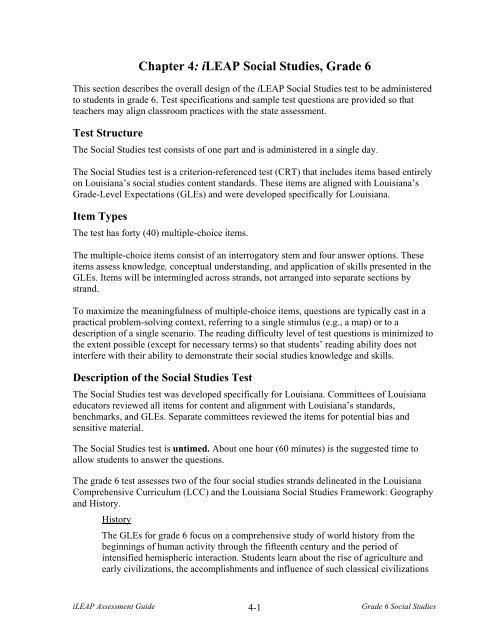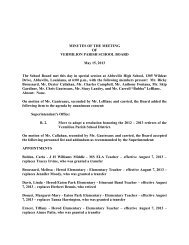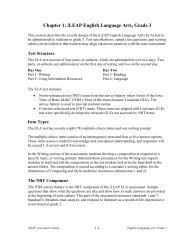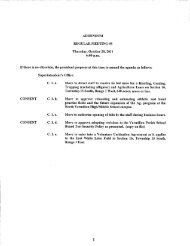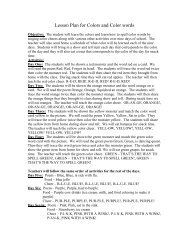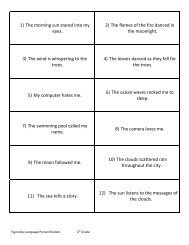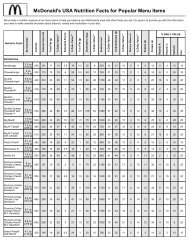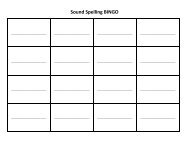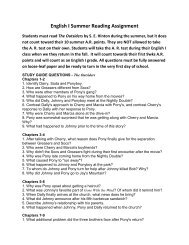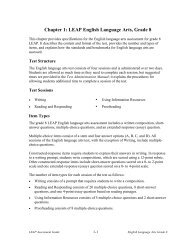Chapter 4: iLEAP Social Studies, Grade 6
Chapter 4: iLEAP Social Studies, Grade 6
Chapter 4: iLEAP Social Studies, Grade 6
- No tags were found...
You also want an ePaper? Increase the reach of your titles
YUMPU automatically turns print PDFs into web optimized ePapers that Google loves.
<strong>Chapter</strong> 4: <strong>iLEAP</strong> <strong>Social</strong> <strong>Studies</strong>, <strong>Grade</strong> 6This section describes the overall design of the <strong>iLEAP</strong> <strong>Social</strong> <strong>Studies</strong> test to be administeredto students in grade 6. Test specifications and sample test questions are provided so thatteachers may align classroom practices with the state assessment.Test StructureThe <strong>Social</strong> <strong>Studies</strong> test consists of one part and is administered in a single day.The <strong>Social</strong> <strong>Studies</strong> test is a criterion-referenced test (CRT) that includes items based entirelyon Louisiana’s social studies content standards. These items are aligned with Louisiana’s<strong>Grade</strong>-Level Expectations (GLEs) and were developed specifically for Louisiana.Item TypesThe test has forty (40) multiple-choice items.The multiple-choice items consist of an interrogatory stem and four answer options. Theseitems assess knowledge, conceptual understanding, and application of skills presented in theGLEs. Items will be intermingled across strands, not arranged into separate sections bystrand.To maximize the meaningfulness of multiple-choice items, questions are typically cast in apractical problem-solving context, referring to a single stimulus (e.g., a map) or to adescription of a single scenario. The reading difficulty level of test questions is minimized tothe extent possible (except for necessary terms) so that students’ reading ability does notinterfere with their ability to demonstrate their social studies knowledge and skills.Description of the <strong>Social</strong> <strong>Studies</strong> TestThe <strong>Social</strong> <strong>Studies</strong> test was developed specifically for Louisiana. Committees of Louisianaeducators reviewed all items for content and alignment with Louisiana’s standards,benchmarks, and GLEs. Separate committees reviewed the items for potential bias andsensitive material.The <strong>Social</strong> <strong>Studies</strong> test is untimed. About one hour (60 minutes) is the suggested time toallow students to answer the questions.The grade 6 test assesses two of the four social studies strands delineated in the LouisianaComprehensive Curriculum (LCC) and the Louisiana <strong>Social</strong> <strong>Studies</strong> Framework: Geographyand History.HistoryThe GLEs for grade 6 focus on a comprehensive study of world history from thebeginnings of human activity through the fifteenth century and the period ofintensified hemispheric interaction. Students learn about the rise of agriculture andearly civilizations, the accomplishments and influence of such classical civilizations<strong>iLEAP</strong> Assessment Guide4-1<strong>Grade</strong> 6 <strong>Social</strong> <strong>Studies</strong>
Most of the grade 6 GLEs are eligible for assessment on the <strong>iLEAP</strong> <strong>Social</strong> <strong>Studies</strong> test.Some, however, do not lend themselves to testing on a statewide assessment in multiplechoiceformat. For the Civics and Economics strands, GLE numbers 11, 12, 13, and 14 arenot directly measured by questions in the grade 6 <strong>iLEAP</strong>. In addition, GLE numbers 15, 17,18, 20, and 21 focus on historical thinking skills that require students to use outside resourcesunavailable during the test; therefore they cannot be assessed in a multiple-choice format.Finally, in accordance with the Comprehensive Curriculum, GLE numbers 45, 46, 47, 48, 49,50, and 52 may not be taught prior to the spring test administration and therefore will not beassessed. It is important, however, that the skills represented by these GLEs are taught at thisgrade level to prepare students for classroom assessment purposes as well as the grade 8LEAP test.Explanation of Codes:GLEs are numbered consecutively in each grade level and grouped by strand and thematiccategory. For example:Strand:Categories:GeographyA. The World in Spatial TermsB. Places and RegionsC. Physical and Human SystemsD. Environment and SocietyBenchmarks are organized into three or four thematic categories within each strand:Geography, Civics, Economics, and History. These categories (e.g., Places and Regions, orHistorical Thinking Skills) provide further content definition by highlighting the underlyingthemes within the domain of each strand.Benchmarks are coded by strand, standard, category, and grade cluster (E, M, H). The firstterm in the code always refers to the strand. The second term gives the standard number andcategory. The third term indicates the grade cluster and benchmark number. The fourth partindicates the GLE number.Table 15 provides two examples of benchmark codes.CodeG-1B-E1-16Table 15: Examples of <strong>Social</strong> <strong>Studies</strong> CodesTranslationGeography, Standard 1, Category B, Elementary Benchmark 1,GLE 16H-1A-H3-9 History, Standard 1, Category A, High School Benchmark 3, GLE 9<strong>iLEAP</strong> Assessment Guide4-4<strong>Grade</strong> 6 <strong>Social</strong> <strong>Studies</strong>
Environment and Society• Effect of physical environments on human activity in ancient civilizations—e.g.,flood plains, deserts, rain forests• Human adaptations of physical environment—e.g., levees and dams, irrigation,canals, trading, growing crops native to environment• Characteristics of hunter-gatherers and desert nomadsHistoryHistorical Thinking Skills• Interpret chronology of dates as presented on vertical and horizontal timelines• Understand that data presented in a timeline represents elapsed time between andwithin elapsed time periods• Describe change and continuity over time• Identify and interpret primary source material—e.g., quotes, literature, artifacts• Distinguish the difference between a primary and secondary sourceWorld History• Hunter-gatherer societies—e.g., wandering and nomadic lifestyle, types of foodhunted, use of animals for clothing and shelter• Building materials used by early civilizations—e.g., Mesopotamia, NativeAmericans• Development of early tools and materials used to create them• Natural resources important to the development of agriculture in earlycivilizations—e.g., availability of fresh water supply, rich soil, temperate climate• Physical barriers that provided ancient civilizations protection• Development of agricultural societies from hunters and gatherers—e.g.,domestication and cultivation, Agricultural Revolution, shortage of available food• Reasons for the domestication of plants and animals• Major climatic changes which led to domestication• Location and characteristics of major river systems—e.g., Tigris and EuphratesRivers, Indus River, Nile River, Huang-He River (“River of Sorrows”)• Characteristics of the major early river valley civilizationso Mesopotamia—e.g., ziggurats, Code of Hammurabi, Sumerian city-states,cuneiformo Egypt—e.g., rule by pharaohs, pyramids and mummification, hieroglyphics,irrigation methods, papyruso Indus Valley—e.g., planned cities of Mohenjo-Daro and Harappa, monsoonwinds, agricultural society, caste systemo China—e.g., ideographs, warrior class, Mandate of Heaven/ rule by dynasty,silk• Trade of goods and spread of ideas between early river valley civilizations• Development of agricultural societies in Southwest Asia, the Mediterranean Basin,and temperate Europe—e.g., methods of food storage, agricultural developmentssuch as irrigation techniques and the plow and their impact, increase of structuredgovernments and defined leaders<strong>iLEAP</strong> Assessment Guide4-6<strong>Grade</strong> 6 <strong>Social</strong> <strong>Studies</strong>
• Military migrations and invasions in Europe and Asia—e.g., Spartans, Hyskos,Aryans, Hittites, Dorians• Origins and influence of the Hittite, Minoan, and Mycenaean civilizations• Introduction of iron tools and weapons in Southwest Asia and the Mediterraneanregion—e.g., metal plow, increased military activity• Phoenician trade in the Mediterranean Basin—e.g., important trading partners suchas Egypt and Greece, exchange of goods and information such as phonetic alphabet,indigo dye and cloth, nautical and shipbuilding skills• Forms of writing developed in early civilizations—e.g., Greek alphabet, Egyptianhieroglyphics, Chinese symbols, Indus Valley pictographs• Cultural achievements of Greece—e.g., establishment of direct democracy inAthens, architecture, polis, literature such as epic poems and plays• Alexander the Great—e.g., education and ancestry, expansion of the Greek empirethrough military conquests (location and methods), spread of Greek culture intoAsia• Influence of Greek ideas about democracy on the Roman Republic and their impacton the founders of the United States• Key characteristics of classical civilizations—e.g., accomplishments in science andengineering, architecture, major goods traded, writing system, language, religiousbeliefs• Compare and contrast the major religions that emerged in the Mediterranean Basin,China, and India (Islam, Judaism, Christianity, Buddhism, Hinduism)—e.g.,location, key beliefs, holy books, holy sites, leaders and founders, common moralbeliefs, symbols• Spread of major religions and cultural traditions—e.g., spread of Islamic empire andChristianity, Emperor Constantine, effect of Roman Crusades, Jewish migration• Effect of major religions on European, Asian, and African civilizations—e.g.,influence of Roman Catholic Church in medieval Europe, architecture of places ofworship, religious motivation for European explorations, caste system of India• Developments brought about by the emergence and collapse of major kingdomsprior to A.D. 1000—e.g., divide of the Roman Empire, romance languages, Goths,expansion of Arabic culture• Major events, key figures, and social structure of the Early Middle Ages—e.g.,feudalism (vassals, serfs, knights, priests, lords, manors), effects of the plague, fallof Rome, accomplishments of Charlemagne• Major innovations in shipbuilding, navigation, and naval warfare—e.g., cannon,telescope, magnetic compass, astrolabe, lateen sail, frigate, galleon, caravel• Accomplishments of Prince Henry the Navigator<strong>iLEAP</strong> Assessment Guide4-7<strong>Grade</strong> 6 <strong>Social</strong> <strong>Studies</strong>
<strong>Grade</strong> 6 <strong>Social</strong> <strong>Studies</strong> Standards, Benchmarks, and GLEsThe following chart presents all grade 6 <strong>Social</strong> <strong>Studies</strong> standards, benchmarks, and GLEs.GRADE 6SOCIAL STUDIES STANDARDS, BENCHMARKS, AND GLESGeography—Physical and Cultural Systems: Students develop a spatial understanding of Earth’ssurface and the processes that shape it, the connections between people and places, and therelationship between man and his environment.A. The World in Spatial TermsBenchmarksG-1A-M1: identifying and describing thecharacteristics, functions, and applications ofvarious types of maps and other geographicrepresentations, tools, and technologiesG-1A-M2: interpreting and developing maps,globes, graphs, charts, models, and databases toanalyze spatial distributions and patternsG-1A-M3: organizing and displaying informationabout the location of geographic features and placesby using mental mapping skillsB. Places and RegionsG-1B-M1: explaining and analyzing both thephysical and human phenomena associated withspecific places, including precipitation andsettlement patternsG-1B-M2: identifying and describing significantphysical features that have influenced historicaleventsG-1B-M3: identifying criteria used to defineregions and explaining how and why regions changeG-1B-M4: describing and explaining how personalinterests, culture, and technology affect people’sperceptions and uses of places and regionsC. Physical and Human SystemsG-1C-M1: predicting and explaining how physicalfeatures help to shape patterns and arrangements inthe physical environmentG-1C-M2: identifying key demographic conceptsand using these concepts to analyze the populationcharacteristics of a country or region<strong>Grade</strong>-Level Expectations1. Use latitude and longitude to determinedirection or locate or compare points on a mapor representation of a globe (G-1A-M2)2. Identify land and climatic conditions conduciveto human settlement in regions of the world anddescribe the role of these conditions (G-1B-M1)3. Identify physical features that influenced worldhistorical events and describe their influence(e.g., the Nile and Tigris-Euphrates as “cradlesof civilization”) (G-1B-M2)4. Explain ways in which goals, cultures, interests,inventions, and technological advances haveaffected people’s perceptions and uses of placesor regions in world history (G-1B-M4)<strong>iLEAP</strong> Assessment Guide4-8<strong>Grade</strong> 6 <strong>Social</strong> <strong>Studies</strong>
G-1C-M3: describing the characteristics andpatterns of human settlement in different regions ofthe world and analyzing the impact of urbanizationG-1C-M4: analyzing types, patterns, and effects ofhuman migration over timeG-1C-M5: tracing local and worldwide patterns ofcultural diffusion and analyzing their causes andeffectsG-1C-M6: comparing historical and contemporarypatterns of economic interdependenceG-1C-M7: explaining how cooperation and conflictamong people contribute to the political divisionson Earth’s surfaceD. Environment and SocietyG-1D-M1: analyzing and evaluating the effects ofhuman actions upon the physical environmentG-1D-M2: explaining and giving examples of howcharacteristics of different physical environmentsaffect human activitiesG-1D-M3: analyzing the worldwide distributionand utilization of natural resourcesG-1D-M4: identifying problems that relate tocontemporary geographic issues and researchingpossible solutions5. Explain reasons for different patterns ofmigration among early peoples (G-1C-M4)6. Explain factors or events that have facilitatedcultural diffusion (e.g., the Silk Road, Crusades)(G-1C-M5)7. Describe the economic interdependence amongvarious ancient civilizations (G-1C-M6)8. Explain how ancient civilizations establishedand maintained political boundaries (G-1C-M7)9. Explain how different physical environmentsaffected human activity in ancient civilizations(G-1D-M2)10. Analyze world or regional distribution ofnatural resources in terms of the need to importor the capacity to export (G-1D-M3)Civics—Citizenship and Government: Students develop an understanding of the structure andpurposes of government, the foundations of the American democratic system, and the role of theUnited States in the world, while learning about the rights and responsibilities of citizenship.A. Structure and Purposes of GovernmentThere are no <strong>Grade</strong>-Level Expectations for benchmarks in grade 6 for this category.B. Foundations of the American Political SystemC-1B-M1: explaining the essential ideas andhistorical origins of American constitutionalgovernmentC-1B-M2: identifying and describing the historicalexperiences and the geographic, social, andeconomic factors that have helped to shapeAmerican political cultureC-1B-M3: explaining the meaning and importanceof basic principles of American constitutionaldemocracy as reflected in core documentsC-1B-M4: analyzing the ways in which politicaland social conflict can be peacefully resolvedC-1B-M5: analyzing democratic processes used toinstitute change11. Identify the essential elements of Greek andRoman government that would later influencethe U.S. government (C-1B-M1)<strong>iLEAP</strong> Assessment Guide4-9<strong>Grade</strong> 6 <strong>Social</strong> <strong>Studies</strong>
C-1B-M6: analyzing the importance of politicalparties, campaigns, and elections in the Americanpolitical systemC. International RelationshipsThere are no <strong>Grade</strong>-Level Expectations for benchmarks in grade 6 for this category.D. Roles of the CitizenThere are no <strong>Grade</strong>-Level Expectations for benchmarks in grade 6 for this category.Economics—Interdependence and Decision Making: Students develop an understanding offundamental economic concepts as they apply to the interdependence and decision making ofindividuals, households, businesses, and governments in the United States and the world.A. Fundamental Economic ConceptsBenchmarksE-1A-M1: describing how the scarcity of resourcesnecessitates decision making at both personal andsocietal levelsE-1A-M2: analyzing consequences of economicdecisions in terms of additional benefits andadditional costsE-1A-M3: analyzing the consequences andopportunity cost of economic decisionsE-1A-M4: analyzing the role of specialization inthe economic processE-1A-M5: giving examples of how skills andknowledge increase productivity and careeropportunitiesE-1A-M6: describing the essential differences inthe production and allocation of goods and servicesin traditional, command, and market systemsE-1A-M7: describing the various institutions, suchas business firms and government agencies, thatmake up economic systemsE-1A-M8: differentiating among various forms ofexchange and moneyE-1A-M9: using economic concepts to help explainhistoric and contemporary events and developments<strong>Grade</strong>-Level Expectations12. Explain the role of expanding specialization inthe development of world civilizations(E-1A-M4)13. Identify the functions and characteristics ofmoney (e.g., money as a store of value) andcompare barter exchange to money exchange(E-1A-M8)14. Use economic concepts (e.g., supply anddemand, interdependence) to describe theeconomic motivations for expanding trade andterritorial domination in world history(E-1A-M9)<strong>iLEAP</strong> Assessment Guide4-10<strong>Grade</strong> 6 <strong>Social</strong> <strong>Studies</strong>
B. Individuals, Households, Businesses, and GovernmentsThere are no <strong>Grade</strong>-Level Expectations for benchmarks in grade 6 for this category.C. The Economy as a WholeThere are no <strong>Grade</strong>-Level Expectations for benchmarks in grade 6 for this category.History—Time, Continuity, and Change: Students develop a sense of historical time and historicalperspective as they study the history of their community, state, nation, and world.A. Historical Thinking SkillsBenchmarks<strong>Grade</strong>-Level ExpectationsH-1A-M1: describing chronological relationshipsand patternsH-1A-M2: demonstrating historical perspectivethrough the political, social, and economic contextin which an event or idea occurredH-1A-M3: analyzing the impact that specificindividuals, ideas, events, and decisions had on thecourse of historyH-1A-M4: analyzing historical data using primaryand secondary sourcesH-1A-M5: identifying issues and problems from thepast and evaluating alternative courses of actionH-1A-M6: conducting research in efforts to answerhistorical questionsB. United States History15. Construct a timeline of key developments inworld history (political, social, technological,religious/cultural) (H-1A-M1)16. Interpret data presented in a timeline to identifychange and continuity in world civilizations(H-1A-M1)17. Describe the defining characteristics of majorworld civilizations from political, social, andeconomic perspectives (H-1A-M2)18. Describe the causes, effects, or impact of agiven historical development or event in worldcivilizations (H-1A-M3)19. Use multiple primary and secondary sources todescribe world civilizations (H-1A-M4)20. Identify historical issues or problems in worldcivilizations and discuss how they wereaddressed (H-1A-M5)21. Conduct historical research using a variety ofresources to answer historical questions relatedto world civilizations (H-1A-M6)There are no <strong>Grade</strong>-Level Expectations for benchmarks in grade 6 for this category.C. World HistoryH-1C-M1: describing the earliest humancommunities22. Describe features of the earliest communities(e.g., shelter, food, clothing) (H-1C-M1)23. Describe hunter-gatherer societies, including thedevelopment of tools and the use of fire(H-1C-M1)<strong>iLEAP</strong> Assessment Guide4-11<strong>Grade</strong> 6 <strong>Social</strong> <strong>Studies</strong>
H-1C-M2: explaining the emergence of agriculturalsocieties around the worldH-1C-M3: identifying the major characteristics ofearly civilizations in Mesopotamia, Egypt, and theIndus valleyH-1C-M4: tracing the development and expansionof agricultural societies and the emergence of newstatesH-1C-M5: analyzing the political, social, andcultural consequences of population movements andmilitarization in Europe and AsiaH-1C-M6: discussing and giving examples oftechnological and cultural innovation and changeH-1C-M7: describing the classical civilizations andexamining their interactions and influences24. Explain how geographical features influenceddevelopment of early civilizations (e.g.,domestication, cultivation, specialization)(H-1C-M2)25. Explain why agricultural societies developedfrom hunters and gatherers (H-1C-M2)26. Discuss the climatic changes and humanmodifications of the physical environment thatgave rise to the domestication of plants andanimals and new sources of clothing (H-1C-M2)27. Locate and describe the major river systems anddiscuss the physical settings that supportedpermanent settlement and early civilizations inMesopotamia, Egypt, China, and the Indusvalley (H-1C-M3)28. Describe the major characteristics of early rivervalley civilizations (H-1C-M3)29. Describe how early river civilizationsinfluenced the development of other culturesthrough trade and cultural diffusion (H-1C-M4)30. Describe the development of agriculturalsocieties and individual communities inSouthwest Asia, the Mediterranean Basin, andtemperate Europe, including the role of plowtechnology (H-1C-M4)31. Identify the effects of migration andmilitarization on the politics and social fabric ofEurope and Asia (H-1C-M5)32. Analyze the origins and influence of the Hittite,Minoan, and Mycenaean civilizations(H-1C-M5)33. Explain the significance of the introduction ofiron tools and weapons in Southwest Asia andthe Mediterranean region (H-1C-M6)34. Explain the significance of Phoenician trade inthe Mediterranean Basin (H-1C-M6)35. Identify forms of writing developed in earlycivilizations and discuss how written recordschanged political, legal, religious, and culturallife (H-1C-M6)36. Describe the development of the Greek citystates,the cultural achievements of Athens, andthe impact of Alexander the Great’s conquests(H-1C-M7)37. Explain the sharing of ideas, goods, and servicesthrough trade between the Greek and Romancivilizations, and the influence of thosecivilizations on other cultures (H-1C-M7)38. Describe and compare/contrast the keycharacteristics of classical civilizations (e.g.,Greek, Roman, Persian, Chinese) (H-1C-M7)<strong>iLEAP</strong> Assessment Guide4-12<strong>Grade</strong> 6 <strong>Social</strong> <strong>Studies</strong>
H-1C-M8: describing and comparing theemergence of major religions and large-scaleempires in the Mediterranean Basin, China, andIndiaH-1C-M9: tracing the expansion of major religionsand cultural traditions and examining the impact oncivilizations in Europe, Asia, and AfricaH-1C-M10: analyzing the political, social, andcultural developments and changes that resultedfrom the rise and fall of empires and kingdoms inEurope, Asia, Africa, and the AmericasH-1C-M11: analyzing the cultural and economicimpact of the interregional system ofcommunication and trade that developed among thepeoples of Europe, Asia, and AfricaH-1C-M12: explaining the developments andevents that led to the political, social, cultural, andeconomic transformation of EuropeH-1C-M13: describing the development andexpansion of complex societies and empires in theAmericasH-1C-M14: explaining the political, cultural, andeconomic developments and trends of major worldregions that resulted in the transformation ofsocieties in the fifteenth through the mid-eighteenthcenturies39. Identify the major new religions and relate themto the empires that emerged in theMediterranean Basin, China, and India (i.e.,Christianity, Hinduism, Buddhism, Islam)(H-1C-M8)40. Compare and contrast the major religions interms of leaders, key beliefs, and location(H-1C-M8)41. Trace the spread of major religions and culturaltraditions (e.g., the migration of Jews, spread ofChristianity, expansion of Islamic rule)(H-1C-M9)42. Identify the effect that the major religions havehad on European, Asian, and Africancivilizations (H-1C-M9)43. Describe the changes and developments broughtabout by the emergence and collapse of majorempires/kingdoms in Europe, Asia, Africa, andthe Americas prior to A.D. 1000 (H-1C-M10)44. Describe major events, key figures, and socialstructure of the Early Middle Ages (e.g., the fallof Rome, Charlemagne, feudalism) (H-1C-M10)45. Identify effects of exploration and trade on theeconomic and cultural development of Europe,Africa, and Asia prior to 1500 (H-1C-M11)46. Explain how communication among regionswas accomplished between A.D 1000 and 1500(H-1C-M11)47. Explain how and why Europe changedpolitically, socially, culturally, or economicallyduring the period of intensified hemisphericinteractions (H-1C-M12)48. Describe the major contributing factors that ledto the Renaissance (H-1C-M12)49. Describe the major contributing factors thatwould lead to the Reformation (H-1C-M12)50. Explain the major social, economic, political,and cultural features of European, African, andAsian societies that stimulated exploration andcolonization (H-1C-M14)51. Identify major technological developments inshipbuilding, navigation, and naval warfare, andtrace the cultural origins of various innovations(H-1C-M14)52. Describe the major achievements of the earlyRenaissance in Europe, including the impact ofinnovations in printing (H-1C-M14)<strong>iLEAP</strong> Assessment Guide4-13<strong>Grade</strong> 6 <strong>Social</strong> <strong>Studies</strong>
H-1C-M15: determining and discussing the impactof the political, agricultural, and industrialrevolutions on societies around the worldH-1C-M16: describing the transformation of worldsocieties that occurred during an era of global tradeand Western dominationH-1C-M17: identifying the causes and worldwideconsequences of major twentieth century conflictsH-1C-M18: identifying and discussing significantpolitical, economic, social, cultural, andtechnological trends that have had an impact on themodern worldD. Louisiana HistoryThere are no <strong>Grade</strong>-Level Expectations for benchmarks in grade 6 for this category.<strong>iLEAP</strong> Assessment Guide4-14<strong>Grade</strong> 6 <strong>Social</strong> <strong>Studies</strong>
Sample Test Items: <strong>Grade</strong> 6 <strong>Social</strong> <strong>Studies</strong>GeographyThe World in Spatial TermsGLE 1—Use latitude and longitude to determine direction or locate or compare points on amap or representation of a globe (G-1A-M2)Use this map to answer question 1.World Map1 A ship is at 20˚ south latitude and 80˚ east longitude. Which best describes thelocation of the ship?A in the middle of the Indian OceanB off the west coast of AfricaC off the west coast of South AmericaD in the middle of the Arctic OceanCorrect response: AMatch to GLE: This item asks students to identify a region, given its latitude and longitude.Other grade 6 <strong>iLEAP</strong> items that measure this GLE may ask students to compare differentlocations or identify the latitude and/or longitude of a map location.<strong>iLEAP</strong> Assessment Guide4-15<strong>Grade</strong> 6 <strong>Social</strong> <strong>Studies</strong>
GeographyPlaces and RegionsGLE 2—Identify land and climatic conditions conducive to human settlement in regions ofthe world and describe the role of these conditions (G-1B-M1)2 Many early civilizations were called riverine cultures because they developed nearrivers. How did the rivers contribute to the survival of these civilizations?A They were a power source for mechanical devices such as waterwheels.B They provided a route for transporting goods to other civilizations.C They provided a fresh water supply and rich soil for growing food.D They formed protective barriers around civilizations.Correct response: CMatch to GLE: This item asks students to explain the significance of rivers to earlycivilizations. Other grade 6 <strong>iLEAP</strong> items that measure this GLE may relate to other land orclimatic conditions and their roles.<strong>iLEAP</strong> Assessment Guide4-16<strong>Grade</strong> 6 <strong>Social</strong> <strong>Studies</strong>
GeographyPlaces and RegionsGLE 3—Identify physical features that influenced world historical events and describe theirinfluence (e.g., the Nile and Tigris-Euphrates as “cradles of civilization”) (G-1B-M2)Use this map to answer question 3.Mesopotamia, 2500 B.C.3 Which two geographical features most likely provided fertile land that gave rise tomultiple city-states in the Mesopotamia region?A Euphrates River and Tigris RiverB Persian Gulf and Arabian DesertC Mediterranean Sea and Red SeaD Zagros Mountains and Caspian SeaCorrect response: AMatch to GLE: This item relates to the importance of the Tigris and Euphrates rivers to therise of civilization. Other grade 6 <strong>iLEAP</strong> items that measure this GLE may relate to otherphysical features and their influence on history.<strong>iLEAP</strong> Assessment Guide4-17<strong>Grade</strong> 6 <strong>Social</strong> <strong>Studies</strong>
GeographyPlaces and RegionsGLE 4—Explain ways in which goals, cultures, interests, inventions, and technologicaladvances have affected people’s perceptions and uses of places or regions in world history(G-1B-M4)4 Which activity made it easier for rulers to control large areas of land in ancientChina?A the use of paper moneyB the spread of BuddhismC the creation of a feudal systemD the invention of the wheelbarrowCorrect response: CMatch to GLE: This item focuses on a social system that allowed rulers to control largerareas of land. Other grade 6 <strong>iLEAP</strong> items that measure this GLE may relate to otherconnections between humans and the land they occupy.<strong>iLEAP</strong> Assessment Guide4-18<strong>Grade</strong> 6 <strong>Social</strong> <strong>Studies</strong>
GeographyPlaces and RegionsGLE 4—Explain ways in which goals, cultures, interests, inventions, and technologicaladvances have affected people’s perceptions and uses of places or regions in world history(G-1B-M4)Use this picture to answer question 5.5 This picture shows an ancient Roman aqueduct. Aqueducts brought water from themountains to lower elevations.How did the use of aqueducts affect settlement in early Roman civilizations?A Farmers were able to keep their crops watered.B Fresh water attracted settlers from other civilizations.C People who lived in dry areas had access to fresh water.D Every family was able to have a private bath in its home.Correct response: CMatch to GLE: This item focuses on a technological advance that allowed humans to livefarther from natural sources of fresh water. Other grade 6 <strong>iLEAP</strong> items that measure thisGLE may relate to other connections between humans and the land they occupy.<strong>iLEAP</strong> Assessment Guide4-19<strong>Grade</strong> 6 <strong>Social</strong> <strong>Studies</strong>
GeographyPhysical and Human SystemsGLE 5—Explain reasons for different patterns of migration among early peoples(G-1C-M4)Use this information to answer question 6.Reasons for MigrationA. Push factors1. Poverty2. Political unrestB. Pull factors1. Better jobs2. _____________6 Maria is making an outline for a school paper. Which factor best completes heroutline?A DroughtB Civil warC OverpopulationD Religious freedomCorrect response: DMatch to GLE: This item focuses on general “push” and “pull” factors that can influencemigration. Other grade 6 <strong>iLEAP</strong> items that measure this GLE may relate to specific humanmigrations throughout history.<strong>iLEAP</strong> Assessment Guide4-20<strong>Grade</strong> 6 <strong>Social</strong> <strong>Studies</strong>
GeographyPhysical and Human SystemsGLE 6—Explain factors or events that have facilitated cultural diffusion (e.g., the Silk Road,Crusades) (G-1C-M5)7 Which outcome was a result of the medieval Crusades?A peace between Christians and MuslimsB European advances in science and architectureC the spread of Christianity throughout the Middle EastD greater knowledge of European geography among MuslimsCorrect response: BMatch to GLE: This item examines the Crusades as a means of cultural diffusion. Othergrade 6 <strong>iLEAP</strong> items that measure this GLE may relate to other factors or events in history.GeographyPhysical and Human SystemsGLE 6—Explain factors or events that have facilitated cultural diffusion (e.g., the Silk Road,Crusades) (G-1C-M5)8 Which early civilization spread the use of a simple alphabet as it traded with otherpeoples?A the ChineseB the EgyptianC the HarrappanD the PhoenicianCorrect response: DMatch to GLE: This item examines trade as a means of cultural diffusion. Other grade 6<strong>iLEAP</strong> items that measure this GLE may relate to other factors or events in history.<strong>iLEAP</strong> Assessment Guide4-21<strong>Grade</strong> 6 <strong>Social</strong> <strong>Studies</strong>
GeographyEnvironment and SocietyGLE 9—Explain how different physical environments affected human activity in ancientcivilizations (G-1D-M2)Use this map to answer question 11.11 This map shows the geography of present-day Oregon. Which region would havebest supported an early Native American farming civilization?A desertB river valleyC coastal rangeD volcanic rangeCorrect response: BMatch to GLE: This item asks students to examine the connection between farming andphysical environment in North America. Other grade 6 <strong>iLEAP</strong> items that measure this GLEmay relate to other human activities and other parts of the world.<strong>iLEAP</strong> Assessment Guide4-23<strong>Grade</strong> 6 <strong>Social</strong> <strong>Studies</strong>
HistoryHistorical Thinking SkillsGLE 16—Interpret data presented in a timeline to identify change and continuity in worldcivilizations (H-1A-M1)Use this timeline to answer question 12.12 Which statement is supported by information in the timeline?A China developed an alphabet before the Phoenicians.B The Shang dynasty ruled after the Qin dynasty.C The Zhou dynasty ruled before the Han dynasty.D China united before it developed a written language.Correct response: CMatch to GLE: This item measures students’ ability to infer the order of events from atimeline. Other grade 6 <strong>iLEAP</strong> items that measure this GLE may ask students to interprettimelines in other ways.<strong>iLEAP</strong> Assessment Guide4-24<strong>Grade</strong> 6 <strong>Social</strong> <strong>Studies</strong>
HistoryHistorical Thinking SkillsGLE 19—Use multiple primary and secondary sources to describe world civilizations(H-1A-M4)Use this passage to answer question 13.“Our constitution does not copy thelaws of neighboring states; we arerather a pattern to others . . .[Our government] favors the manyinstead of the few; this is why it iscalled a democracy. If we look tothe laws, they [give] equal justice toall . . .The freedom which we enjoy inour government extends also to ourordinary life.”—Thucydides, ancient historian13 This speech most likely describedA China.B Rome.C Greece.D Egypt.Correct response: CMatch to GLE: This item asks students to recognize the description of a society from a primarysource. Other grade 6 <strong>iLEAP</strong> items that measure this GLE may relate to the importance ofprimary and secondary sources in learning about the world.<strong>iLEAP</strong> Assessment Guide4-25<strong>Grade</strong> 6 <strong>Social</strong> <strong>Studies</strong>
HistoryHistorical Thinking SkillsGLE 19—Use multiple primary and secondary sources to describe world civilizations(H-1A-M4)14 Trevor is writing a report about life in modern China. His teacher asked him to use aprimary source and two secondary sources. Which resource could Trevor use as aprimary source?ABCDthe diary of a Chinese poetan encyclopedia article about Chinaa chapter about China from his history booka timeline showing major events in Chinese historyCorrect response: AMatch to GLE: This item asks students to distinguish between primary and secondarysources. Other grade 6 <strong>iLEAP</strong> items that measure this GLE may present information usingprimary or secondary sources and test student understanding.HistoryWorld HistoryGLE 23—Describe hunter-gatherer societies, including the development of tools and the useof fire (H-1C-M1)15 Which statement correctly describes early hunter-gatherer societies?A They relied on farming for most of their food supply.B They traveled with large surpluses of food.C They often changed their physical location.D They usually lived together in large cities.Correct response: CMatch to GLE: This item asks students to recognize a characteristic of hunter-gatherersocieties. Other grade 6 <strong>iLEAP</strong> items that measure this GLE may ask students to describe theway that hunter-gatherers used certain tools.<strong>iLEAP</strong> Assessment Guide4-26<strong>Grade</strong> 6 <strong>Social</strong> <strong>Studies</strong>
HistoryWorld HistoryGLE 24—Explain how geographical features influenced development of early civilizations(e.g., domestication, cultivation, specialization) (H-1C-M2)16 Which feature was a necessity for early settlements?A a warm climateB nearby water sourcesC access to metals such as ironD large, flat areas for constructing housesCorrect response: BMatch to GLE: This item focuses on the dependency by early civilizations on nearby sourcesof food. Other grade 6 <strong>iLEAP</strong> items that measure this GLE may ask students about otherconditions that made certain locations favorable for human settlement.HistoryWorld HistoryGLE 25—Explain why agricultural societies developed from hunters and gatherers(H-1C-M2)17 Which is the most likely reason that hunter-gatherers began farming?A a scarcity of foodB a loss of technologyC wars among groupsD a decline in populationCorrect response: AMatch to GLE: This item addresses one reason why agricultural societies emerged fromhunter-gatherer societies. Other grade 6 <strong>iLEAP</strong> items that measure this GLE may addressother reasons for the emergence of agricultural societies.<strong>iLEAP</strong> Assessment Guide4-27<strong>Grade</strong> 6 <strong>Social</strong> <strong>Studies</strong>
HistoryWorld HistoryGLE 27—Locate and describe the major river systems and discuss the physical settings thatsupported permanent settlement and early civilizations in Mesopotamia, Egypt, China, andthe Indus valley (H-1C-M3)Use this map to answer question 18.Major River Systems18 Which number on the map labels the river that most directly contributed to thedevelopment of ancient Egypt?A number 1B number 2C number 3D number 4Correct response: AMatch to GLE: This item asks students to connect the Nile River with ancient Egyptiandevelopment and locate the Nile on a map. Other grade 6 <strong>iLEAP</strong> items that measure thisGLE may involve other river systems and/or physical settings and ask students to locate themon a map.<strong>iLEAP</strong> Assessment Guide4-28<strong>Grade</strong> 6 <strong>Social</strong> <strong>Studies</strong>
HistoryWorld HistoryGLE 29—Describe how early river civilizations influenced the development of othercultures through trade and cultural diffusion (H-1C-M4)Use this map to answer question 19.Indus River Valley and Surrounding Areas19 This map shows the area inhabited by the ancient Indus River Valley civilization.Archaeologists have discovered stone seals from the Indus River Valley civilizationin both Israel and Iraq.What is the most common theory for how these seals came to be located in the IndusRiver Valley?A Severe weather caused the seals to be carried across the ocean.B The seals were stolen by invaders and hidden in other lands.C Merchants from the Indus River Valley traded with merchants from the MiddleEast.D The people of the Indus River Valley eventually migrated to modern-day Israeland Iraq.Correct response: CMatch to GLE: This item identifies a result of trade between the Indus River Valleycivilization and other parts of the world. Other grade 6 <strong>iLEAP</strong> items that measure this GLEmay involve other river civilizations and their influence through trade and cultural diffusion.<strong>iLEAP</strong> Assessment Guide4-29<strong>Grade</strong> 6 <strong>Social</strong> <strong>Studies</strong>
HistoryWorld HistoryGLE 32—Analyze the origins and influence of the Hittite, Minoan, and Mycenaeancivilizations (H-1C-M5)20 Which features of Mycenaean civilization came from the Minoans?A their religious beliefs and practicesB their alphabet and system of writingC their use of an army to conquer nearby peoplesD their building of settlements on the Greek mainlandCorrect response: BMatch to GLE: This item examines the influence of the Minoan civilization on theMycenaeans. Other grade 6 <strong>iLEAP</strong> items that measure this GLE may relate to other aspectsof Hittite, Minoan, or Mycenaean civilizations.HistoryWorld HistoryGLE 34—Explain the significance of Phoenician trade in the Mediterranean Basin(H-1C-M6)21 Why did the Phoenicians establish dozens of colonies along the Mediterranean coast?A to improve and expand tradeB to spread their religious beliefsC to protect their main cities from attackD to explore new territories in Europe and AfricaCorrect response: AMatch to GLE: This item identifies the relationship between Phoenician trade and thecolonization of areas along the Mediterranean coast. Other grade 6 <strong>iLEAP</strong> items thatmeasure this GLE may relate to other ways in which Phoenician trade was significant.<strong>iLEAP</strong> Assessment Guide4-30<strong>Grade</strong> 6 <strong>Social</strong> <strong>Studies</strong>
HistoryWorld HistoryGLE 35—Identify forms of writing developed in early civilizations and discuss how writtenrecords changed political, legal, religious, and cultural life (H-1C-M6)Use this picture to answer question 22.22 To which ancient civilization did this form of writing belong?A GreekB HebrewC EgyptianD SumerianCorrect response: AMatch to GLE: This item asks students to recognize Greek letters. Other grade 6 <strong>iLEAP</strong>items that measure this GLE may involve other forms of writing and their effects on political,legal, religious, and cultural life.<strong>iLEAP</strong> Assessment Guide4-31<strong>Grade</strong> 6 <strong>Social</strong> <strong>Studies</strong>
HistoryWorld HistoryGLE 36—Describe the development of the Greek city-states, the cultural achievements ofAthens, and the impact of Alexander the Great’s conquests (H-1C-M7)Use this concept web to answer question 23.early formofdemocracyperformancesof music anddramaAncientAthens?23 Which feature best completes the web?A belief in only one godB absolute rule by emperorsC buildings made from straw and clayD lessons in mathematics and philosophyCorrect response: DMatch to GLE: This item asks students to connect the cultural achievements of Athensthrough a concept web. Other grade 6 <strong>iLEAP</strong> items that measure this GLE may relate to thedevelopment of city-states or the impact of Alexander the Great and will not necessarily bepresented through concept webs.<strong>iLEAP</strong> Assessment Guide4-32<strong>Grade</strong> 6 <strong>Social</strong> <strong>Studies</strong>
HistoryWorld HistoryGLE 37—Explain the sharing of ideas, goods, and services through trade between the Greekand Roman civilizations, and the influence of those civilizations on other cultures (H-1C-M7)24 Latin was the language written and spoken in ancient Rome. Which group of modernlanguages is most influenced by Latin?A Italian, French, SpanishB German, English, DutchC Chinese, Japanese, KoreanD Danish, Norwegian, SwedishCorrect response: AMatch to GLE: This item examines an influence of Roman civilization on the modern world.Other grade 6 <strong>iLEAP</strong> items that measure this GLE may relate to other influences of Romanand/or Greek civilization on different cultures and civilizations.HistoryWorld HistoryGLE 38—Describe and compare/contrast the key characteristics of classical civilizations(e.g., Greek, Roman, Persian, Chinese) (H-1C-M7)25 Which two ancient civilizations had the most similar religious beliefs?A Greek and PersianB Roman and GreekC Chinese and RomanD Persian and ChineseCorrect response: BMatch to GLE: This item focuses on the similarity between Greek and Roman religiousbeliefs. Other grade 6 <strong>iLEAP</strong> items that measure this GLE may ask students to compare orcontrast other elements of classical civilizations.<strong>iLEAP</strong> Assessment Guide4-33<strong>Grade</strong> 6 <strong>Social</strong> <strong>Studies</strong>
HistoryWorld HistoryGLE 38—Describe and compare/contrast the key characteristics of classical civilizations(e.g., Greek, Roman, Persian, Chinese) (H-1C-M7)Use this list to answer question 26.• believed in many different gods• had a democratic form of government• held legal trials with juries made up of ordinary citizens26 Which ancient civilization is best described by the list?A ancient EgyptB ancient ChinaC ancient RomeD ancient GreeceCorrect response: DMatch to GLE: This item asks students to connect polytheism, democracy, and jury trialswith ancient Greece. Other grade 6 <strong>iLEAP</strong> items that measure this GLE may ask students tocompare or contrast other elements of classical civilizations.<strong>iLEAP</strong> Assessment Guide4-34<strong>Grade</strong> 6 <strong>Social</strong> <strong>Studies</strong>
HistoryWorld HistoryGLE 39—Identify the major new religions and relate them to the empires that emerged inthe Mediterranean Basin, China, and India (Christianity, Hinduism, Buddhism, Islam)(H-1C-M8)Use this list of statements to answer question 27.• This religion began in India but spread into other parts of Asia.• This religion is common today in Tibet and Japan.• Followers of this religion seek enlightenment.• The leader of this religion is called the Dalai Lama.27 Which major world religion is best described by the statements listed above?A IslamB JudaismC HinduismD BuddhismCorrect response: DMatch to GLE: This item asks students to recognize Buddhism from descriptions of itsorigins, spread, purpose, and leader. Other grade 6 <strong>iLEAP</strong> items that measure this GLE mayask students to identify other major religions and their influence on emerging empires.<strong>iLEAP</strong> Assessment Guide4-35<strong>Grade</strong> 6 <strong>Social</strong> <strong>Studies</strong>
HistoryWorld HistoryGLE 40—Compare and contrast the major religions in terms of leaders, key beliefs, andlocation (H-1C-M8)Use this concept web to answer question 28.IslamChristianity?Judaism28 Which trait best completes the web?A Jesus as religious leaderB use of same holy bookC belief in only one godD holy city of MeccaCorrect response: CMatch to GLE: This item asks students to identify a commonality among Islam, Christianity,and Judaism. Other grade 6 <strong>iLEAP</strong> items that measure this GLE may ask students tocompare or contrast major world religions in other ways.<strong>iLEAP</strong> Assessment Guide4-36<strong>Grade</strong> 6 <strong>Social</strong> <strong>Studies</strong>
HistoryWorld HistoryGLE 43—Describe the changes and developments brought about by the emergence andcollapse of major empires/kingdoms in Europe, Asia, Africa, and the Americas prior toA.D. 1000 (H-1C-M10)29 Which group most increased its power when the Roman Empire fell?A the Roman generalsB the Christian churchC the Roman land ownersD the Persian EmpireCorrect response: BMatch to GLE: This item asks students to describe an outcome of the Roman Empire’scollapse. Other grade 6 <strong>iLEAP</strong> items that measure this GLE may ask students to describehow the emergence or collapse of other empires/kingdoms influenced the course of historyprior to A.D. 1000.HistoryWorld HistoryGLE 44—Describe major events, key figures, and social structure of the early Middle Ages(e.g., the fall of Rome, Charlemagne, feudalism) (H-1C-M10)30 Feudal systems were common in the early Middle Ages. In a feudal system, lords gaveland to their vassals in exchange forA crops.B livestock.C medical care.D military service.Correct response: DMatch to GLE: This item asks students to describe the social and political structure of theearly Middle Ages. Other grade 6 <strong>iLEAP</strong> items that measure this GLE may ask students todescribe major events and key figures.<strong>iLEAP</strong> Assessment Guide4-37<strong>Grade</strong> 6 <strong>Social</strong> <strong>Studies</strong>


